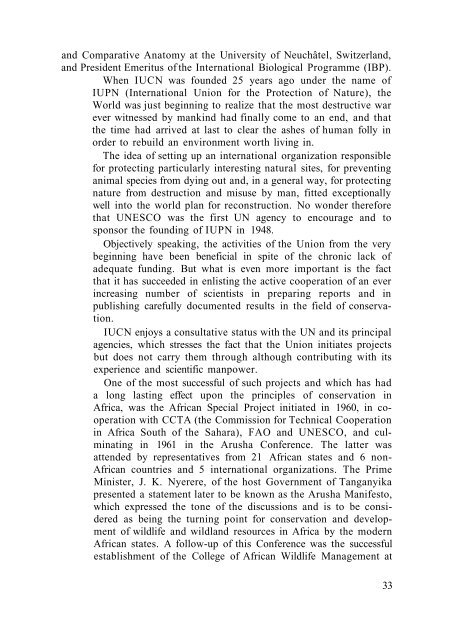1973 iucn yearbook
1973 iucn yearbook
1973 iucn yearbook
You also want an ePaper? Increase the reach of your titles
YUMPU automatically turns print PDFs into web optimized ePapers that Google loves.
and Comparative Anatomy at the University of Neuchâtel, Switzerland,<br />
and President Emeritus of the International Biological Programme (IBP).<br />
When IUCN was founded 25 years ago under the name of<br />
IUPN (International Union for the Protection of Nature), the<br />
World was just beginning to realize that the most destructive war<br />
ever witnessed by mankind had finally come to an end, and that<br />
the time had arrived at last to clear the ashes of human folly in<br />
order to rebuild an environment worth living in.<br />
The idea of setting up an international organization responsible<br />
for protecting particularly interesting natural sites, for preventing<br />
animal species from dying out and, in a general way, for protecting<br />
nature from destruction and misuse by man, fitted exceptionally<br />
well into the world plan for reconstruction. No wonder therefore<br />
that UNESCO was the first UN agency to encourage and to<br />
sponsor the founding of IUPN in 1948.<br />
Objectively speaking, the activities of the Union from the very<br />
beginning have been beneficial in spite of the chronic lack of<br />
adequate funding. But what is even more important is the fact<br />
that it has succeeded in enlisting the active cooperation of an ever<br />
increasing number of scientists in preparing reports and in<br />
publishing carefully documented results in the field of conservation.<br />
IUCN enjoys a consultative status with the UN and its principal<br />
agencies, which stresses the fact that the Union initiates projects<br />
but does not carry them through although contributing with its<br />
experience and scientific manpower.<br />
One of the most successful of such projects and which has had<br />
a long lasting effect upon the principles of conservation in<br />
Africa, was the African Special Project initiated in 1960, in cooperation<br />
with CCTA (the Commission for Technical Cooperation<br />
in Africa South of the Sahara), FAO and UNESCO, and culminating<br />
in 1961 in the Arusha Conference. The latter was<br />
attended by representatives from 21 African states and 6 non-<br />
African countries and 5 international organizations. The Prime<br />
Minister, J. K. Nyerere, of the host Government of Tanganyika<br />
presented a statement later to be known as the Arusha Manifesto,<br />
which expressed the tone of the discussions and is to be considered<br />
as being the turning point for conservation and development<br />
of wildlife and wildland resources in Africa by the modern<br />
African states. A follow-up of this Conference was the successful<br />
establishment of the College of African Wildlife Management at<br />
33

















